So let me share my "secrets" to getting great B&W results from the Fuji X100S with you.
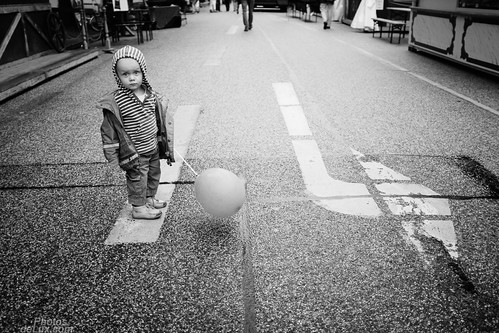 |
| B&W photography can give your photography a new direction |
I started my photography with a cheap plastic camera from a grab bag and a roll of B&W film in the 70's. I must have been 5 or 6 years old at that time. I guess that is where my emotional attachment to B&W photography started.
But when I switched to mainly digital cameras I shot generally in color. This was in big part due to the fact that I did not like the in camera results that the JPG B&W modes produced. And once the color file ended up on my computer, I often just stuck with color.
But since I own the Fuji X100S this has changed! The Fuji X-Cameras create superb color files straight out of the camera. But for the B&W lover in you, Fuji has also created some wonderful B&W filters.
 |
| This reflection would have drowned in a busy color background |
My favorite B&W setting on the X100S for most situations are:
- Film simulation: B-R (B&W Red Filter)
- Sharpness: +1
- Highlight Tone: +1
- Shadow Tone: +2
- Noise Reduction: -2
This will give you a fairly contrasty B&W look when exposed correctly.
 |
| The lack of color can be visually relaxing |
And in case you don't have a lot of experience with B&W photography the Fuji X cameras with EVF or LCD will take you by the hand and guide you to your first successful exposures. When you switch your JPG to B&W you will see a B&W image in the EVF / LCD preview. Now use the exposure compensation dial (in Aperture priority mode) to increase or decrease the exposure and get a more predominant black or white look.
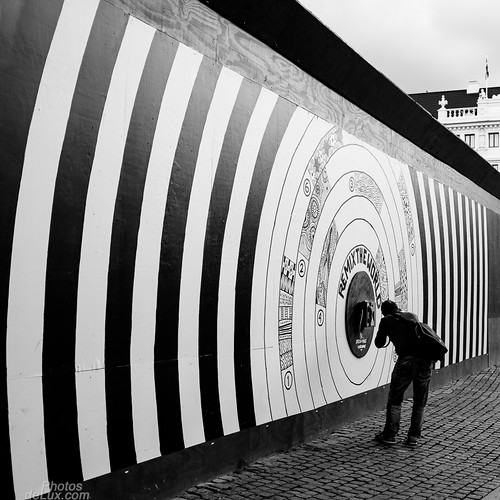 |
| B&W works great for structures and patterns |
Through the live preview in the EVF I got this next photo exposed the way I wanted in my first try. It feels like cheating, but the result is what counts! ;)
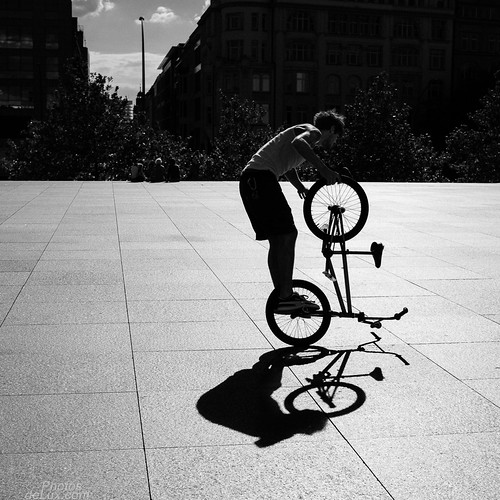 |
| Got this exposed the way I wanted on the first try - and this pose in motion would not have had time for a second try |
This is a X100S portrait with my B&W settings plus on board fill flash straight out of the X100S:
 |
| This is a JPG straight out of camera! |
If I still want some more contrast in my photo I upload the JPG file to my iPad and do some quick adjustments - et voilà!
 |
| The sun flare was visible in the EVF. This way I was able to time it just right when the ship passed underneath it. |
Still not sure if you want to deprive your exposures of the color for good? No problem! Set the Fuji X100S to shoot JPG + RAW and the RAW file will contain all of the color information just in case you change your mind later. The EVF will still show the B&W preview. Feels like cheating again? Don't worry! It is all about the images that come out of the camera :)
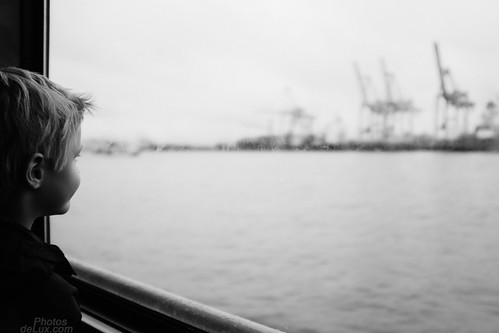 |
| Be adventurous and try to some B&W photos with your Fuji X-Camera |
I have to admit that I sometimes shoot JPG + RAW and end up using the RAW file to convert it into a B&W JPG in post processing. I will do this when I shoot in very contrasty situations and might need to recover some highlights later. The other occasion is when I shoot close to or at ISO 6400. I have set the Noise Reduction to -2 but at those high ISO the X100S tends to smooth out a bit too much details despite the NR -2 setting.
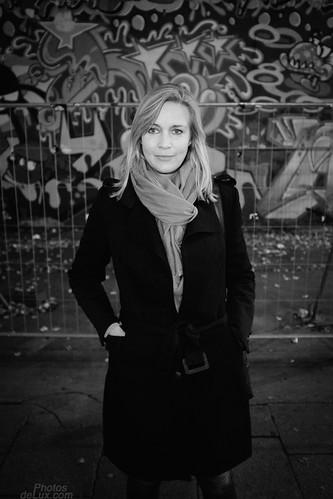 |
| At ISO 6400 I prefer RAW to keep more details |
So, are you ready to give it a try? Then why not just save the B&W settings as one of your custom settings in your X100S for those occasions when you feel like shooting Monochrome :)
 |
| The Fuji X100S is the perfect B&W camera for me! |
If you have any further questions or want to share your Fuji X B&W experiences just leave a comment below, Twitter me @HamburgCam or visit my Homepage at www.MarcoLarousse.com
And if you liked my post I am always happy if you spread the word and retweet, like or google +1 it :-)


I find the omission of the B&W filter previews on the XM1 and XA1 to be limiting. It's wonderful that you can actually see the effects of the red and yellow filters using the EVF on the X-E1 and X-P1. Quite an aid in visualizing the B&W output.
ReplyDeleteReally? The XM1 and XA1 both don't show the B&W previews on the display?
DeleteThe XM1 and XA1 have no B&W filter simulations (yeah, I think a silly move by Fuji but whatever).
DeleteLovely shots as always. On the X100s, I find myself shooting quite a lot in B&W as well. I love contrast so Monochrome + R Filter is my favourite.
ReplyDeleteThank you Mat! We seem to share a similar taste in the look of our B&W images :)
DeleteHi, great photos and a perfect showcase for the fuji x cameras when it comes to b&w.
ReplyDeleteI myself shoot primarily in b&w, my camera is always set to shoot b&w, on the rare occasion I need colour I use the raw file, most of my work uses the jpg.
I think the x cameras are superb for b&w and I find the range of tones is fantastic and produces amazing results when processed right. Thanks for your time in posting the examples. Cheers jon
Thank you for sharing and commenting Jon :)
DeleteThanks a lot for this great post! Very useful info! I do not have an X100 or X100S but I will try these settings on my X10.
ReplyDeleteI have gotten very good results with my X10 and B&W, too!
DeleteNice protips. Thanks! One question, do you use auto ISO?
ReplyDeleteYes, I use Auto ISO most of the time. Only when I need more control over shutter time I switch it off.
DeleteJust one question also : what about the dynamic ? Did you set to Auto Mode ?
Delete(I just discover your website today and I will look at it more often cause I find it really helpful for x-users. Great posts.)
Thanks for the b&w tips. My own x100s is on its way right now, and I'll certainly give these settings a spin!
ReplyDeleteLet me know how they work out for you.
DeleteVery informative tips.
ReplyDeleteI have been working on shooting social dancers in a salsa studio/ club setting. There's a lot of movement and I have to use zone focusing on my XE-1. I want the faces to have nice smooth skin tones, but the background can be contrasty, or even blown out is no problem if it's a stray strobe light. Any thoughts on tweaking these settings for this situation?
Here's an example of what I am working on :
http://www.flickr.com/photos/10148140@N07/10497897144/
Your settings look good to me. But you could use a bit of a fill flash to counter the bright lights in the background. Or you can post process some local lighting up faces and using a vignett to tune out the bright background and aim your viewer towards the faces.
DeleteI love the x100, a question. what program are you using on your ipad?
ReplyDeleteMost of the time I use Snapseed as it gives me a quick workflow on the road.
DeleteThanks for the tips! Will give it a try the coming time.
ReplyDeleteYou are welcome :)
DeleteI have been converting all my digital color RAW files to b&w for the last five years. When I shifted from DSLRs to the X100S (retired newspaper shooter), I picked up on this capability real quick. I have mine set to shoot RAW only but have the film simulation set to b&w on both my X100S and my X-E1 just so I can see what the b&w possibilities are. I go between the green filter and the red filter depending on the situation.
ReplyDeleteYes, I find it really helpful to see the image in greyscale when choosing exposure. And sometimes I just go with the B&W JPG that I shoot in addition to the RAW file. It makes things a bit easyer when I use my iPad on the road for PP and uploading :)
DeleteVery good work. Do you always use the same aperture for this photos ?
ReplyDeleteThanks
Jean-François from Paris
I use f2 most of the time (plus ND filter in bright situations). But for landscape I'll go up to f5.6 but hardly ever above that.
DeleteSome wonderful images especially the last one which has a timeless quality to it
ReplyDeleteNice pictures. I bought mine today in black.
ReplyDeleteYou have an excellent b&w work. I bought a x100s recently and I wonder how you get those silvered/grey tones of some of your pictures (i.e. the one with the ship and the sun flare). Can you tell me a little more about it?
ReplyDeleteI generally use the B&W JPG settings in camera as described in my post. On difficult lighting scenes (like the ship woth the sun flare) I sometimes go back to the color RAW file and tweak it to be a B&W image in LightRoom. This gives me the chance to tone individual color channes to the grey intensity that I seek This is the digital version of adding i.e. a red filter to your lens when you shoot B&W film to give you more contrast in the sky.
DeleteHi, saw your portfolio at flickr. Amazing! I have a X-E2 and have been using a very different workflow. I take color RAW pictures, post process to exaggerate colors even more and use DxO Filmpack to turn them B&W. One can choose some old films to emulate and apply grain and filters to taste. What do you think? This is an example: http://500px.com/photo/71168957/sunny-day-in-s%C3%A3o-luis-by-murilo-peralta?from=users_library
ReplyDeleteExcellent write up and wonderful photos. Thank you
ReplyDeleteIt's irritating when people think that merely adding a black and white filter to a photo makes a good photograph! This goes to show that there is a real artistry to it.
ReplyDeleteVery cool article with great pics. Thanks for sharing experencies!
ReplyDelete